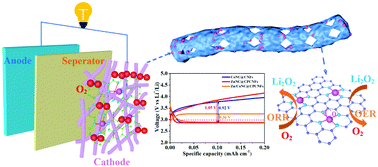Electrospun ZIF-derived cavity porous carbon nanofibers as a freestanding cathode for lithium–oxygen batteries with ultralow overpotential†
Abstract
Construction of an efficient electrocatalyst for the oxygen reduction reaction (ORR) and oxygen evolution reaction (OER) with low overpotential and cycling stability for lithium–oxygen batteries still remains a puzzling challenge. Herein, we propose a scalable approach to integrate ZIF derivatives into cavity porous carbon nanofibers (CPCNFs) via an electrospinning technique and thermal treatment (Zn/CoNC@CPCNFs). The ultralong interconnected nanofiber matrix is beneficial, and the developed Zn/CoNC@CPCNFs catalyst with excellent flexibility can be utilized as a free-standing electrode based on an air-cathode. Moreover, this confinement strategy ensures the dispersion of Co-based species and abundant porosity structure, which contributes to the transport and adsorption of oxygen and exposes more Co–N coordination catalytic centers, as a result of a drastically ultralow voltage gap. Consequently, a cell based on a Zn/CoNC@CPCNF electrode presents remarkably decreased charge–discharge polarization (0.36 V), a high initial discharge capacity with an ultra-low overpotential of 0.59 V, and long-term cyclability with a cut-off capacity of 0.2 mA h cm−2 at 0.02 mA cm−2. We hope that our protocol will offer instruction for the design and application of oxygen electrocatalysts for energy conversion and storage.

- This article is part of the themed collection: 2021 Nanoscale HOT Article Collection


 Please wait while we load your content...
Please wait while we load your content...